#team Jimbo
Text
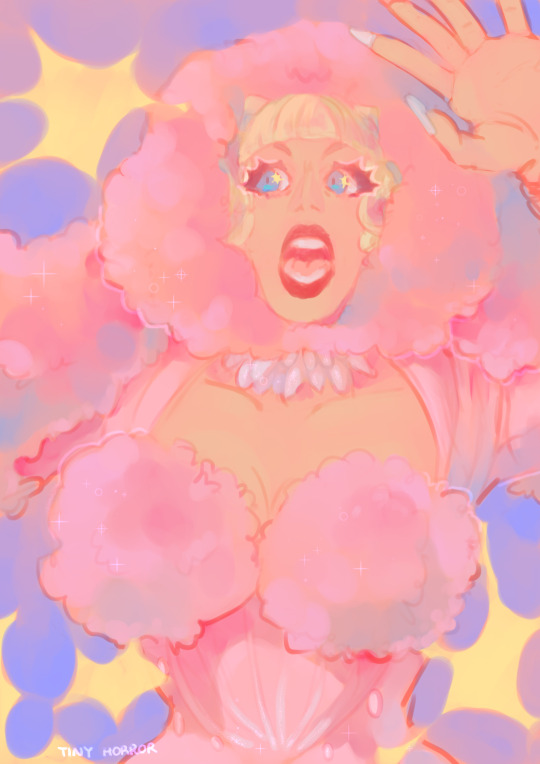
i’m Team Clown….. i mean #TeamJimbo ! 🎪💘💕💞
insta | twitter | inprnt | redbubble
#rpdr#rpdr all stars#rupauls drag race#drag race#jimbo the drag clown#jimbo#team jimbo#my art#csp#clip studio paint#own art#artists on tumblr#small artist#fanart#digital artist#digital art#pink art#drag race fanart#rpdr fanart#all stars 8#as 8#ukrainian artist#ukrainian tumblr#укр арт#укртумбочка#украрт
89 notes
·
View notes
Text




May we talk about how this year we crowned the four best winners of all time May we talk about how this year we have crowned the four best winners of all time.
Sasha Colby
https://instagram.com/sashacolby?igshid=MzRlODBiNWFlZA==
https://twitter.com/sashacolby
Jimbo
https://www.instagram.com/jimbothedragclown/?hl=en
https://twitter.com/jimbodragclown
Keiona
https://instagram.com/keiona____/
https://www.tiktok.com/@keiona____
https://twitter.com/Keiona__
Cristian Peralta
https://www.instagram.com/cristianperaltatranformista/
these queens have pCharisma to win the peoples hearts before the even got on. The Uniqueness to be themselves and never change who they are. The Nerve to never place below high and the Talent to Win 5 times.
#rupauls drag race#drag race#canadas drag race#all stars#drag race France#drag race mexico#team keiona#team sasha Colby#team Jimbo#Team Christian Peralta
5 notes
·
View notes
Note
what're your opinions on the other companies?
ipsn is fucking awesome, their mechs are reliable, their nhps are quirky as fuck, theyre not ssc, theyre not weird like horus and the quality of their products and services is amazing
horus is a bunch of tweakers piloting mechs that tweakers shouldnt pilot, or should, depends on how you look at it, but i do have to say that their entire thing is pretty neat, and yes i know theyre not a company but whatever
ssc is fucking boring, luxury mechs (with feet or hooves) for people who probably pay for feet pics (hoof pics too i guess)? checks out
@hra-official is just cool, i respect the hustle
and ktb is also really cool, i dont hate them, i dont think even management really hates them, i just wish we could like, share the dawnline shore together because if people like good old Ferdinand (the guy who manages @ktbofficial) exist in the ktb then i think theyre pretty awesome, though just like any other government; theyre shady as all fuck, but what government (or company) isnt really
#lancer rpg#lancer#lancerrpg#mecha#harrison armory#smith shimano#interplanetary shipping northstar#karrakin trade baronies#hercynian refurbished armory#horus#jimbos note: harrison armory is shady as fuck but i dont manufacture for them#and i dont even really post for them#they just kind of pay me to have opinions on the omninet to be “hip with the younguns”#management doesnt even really monitor me after they fired most of the team we had and promoted me
29 notes
·
View notes
Text



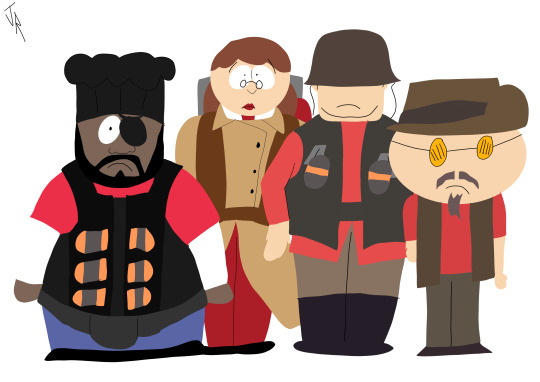

South Park Art Dump
#south park#south park fanart#chef south park#south park chef#liane cartman#eric cartman#jimbo kern#ned gerblansky#sharon marsh#butters stotch#cartoonart#cartoons#tf2#team fortress 2#deftones#korn band#korn follow the leader#deftones around the fur#korn
41 notes
·
View notes
Text

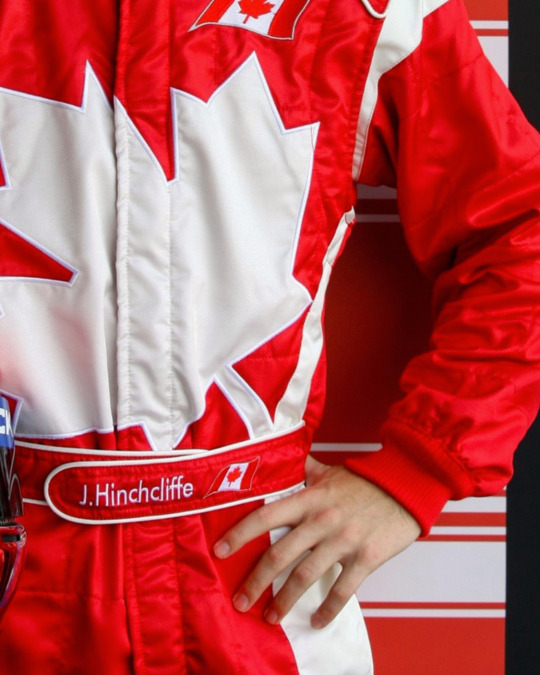
happy 37th birthday james hinchcliffe! 🍁 (december 5, 1986)
#happy birthday jimbo ♥️#james hinchcliffe#indycar#julian avram/a1gp team#*#I enjoyed looking at pictures of james for hours but nothing sparked any creativity so.#patriotism it is#but i do have lots of sets for the queue now :)
14 notes
·
View notes
Text






The movie may sure take place in a different timeline, but i think that it's having some S3 elements in it, like Willy being with Mira, meaning that somehow, the Mission Teams are currently happening, or Jimbo not working at the control tower just like in S3 and being a circulation agent (in the case of the movie, he look more as vehicle repair/doing the maintenance of stuff)
#super wings#super wings the movie: maximum speed#super wings the movie#jett#jimbo#zoey#season 3#mission teams
15 notes
·
View notes
Text
jimbo casually bringing up his bromance with troch AND their broad history together like way way way back and that was a lovely surprise?? hello new ship badum-tss
#❝ text#listen i never knew i just liked jimbo when he was a blueshirt#& then he came back#now this revelation?!#a team of boyfriends srsly
6 notes
·
View notes
Note
Jimbo just checking in again, we can't have you dying now! Not before you post a review at least! I know you requested a rock climbing model, but I think we should hook you up with the Bolt Max Pro. It's got a built in vibration motor and a lithium battery good for 5 hours on a single charge. It can also be used as a defibrillator in a pinch!
AS A DEFIBRILLATOR
Dick so good she goes into cardiac arrest but DON’T WORRY! Ur life saver is LESS THAN A METER AWAY
#you should hire me onto ur marketing team jimbo xx#can I get both tho I’m really intrigued by the rock climbing dick ngl
2 notes
·
View notes
Text
oh no but heidi should have won
#rpdr as8 spoilers#I do love jessica but i don't really think she'll win#I was more team jimbo before these lousy lipsyncs im just kinda order it
0 notes
Text
jimbo doing all the drag race seasons huh. honestly deserved
#ame rambles#i was team jimbo back when drcan aired#i also stopprd watching ukvtw after jimbo got eliminated
0 notes
Text

Artfight attack 7 of 12 for my old friend greaserica!!!
1 note
·
View note
Text

#csp#clip studio paint#my art#digital artist#digital art#fanart#small artist#own art#artists on tumblr#jimbo#jimbo the clown#wip art#wop#work in progress#drag race#rupauls drag race#rpdr#rpdr all stars#team jimbo
5 notes
·
View notes
Text
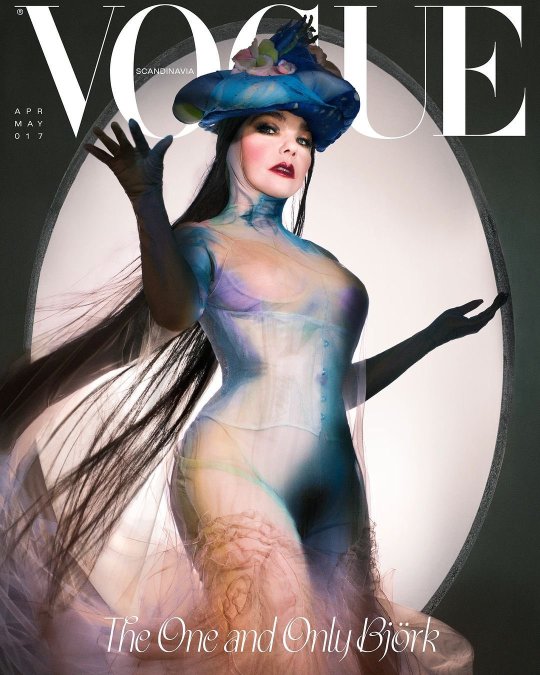
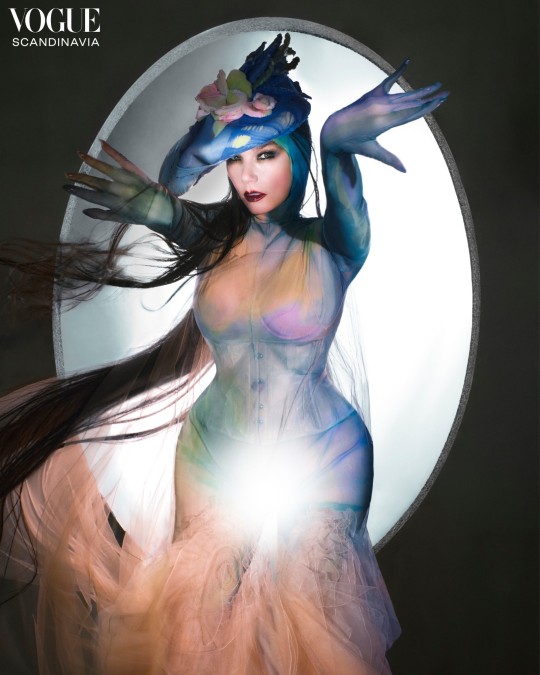
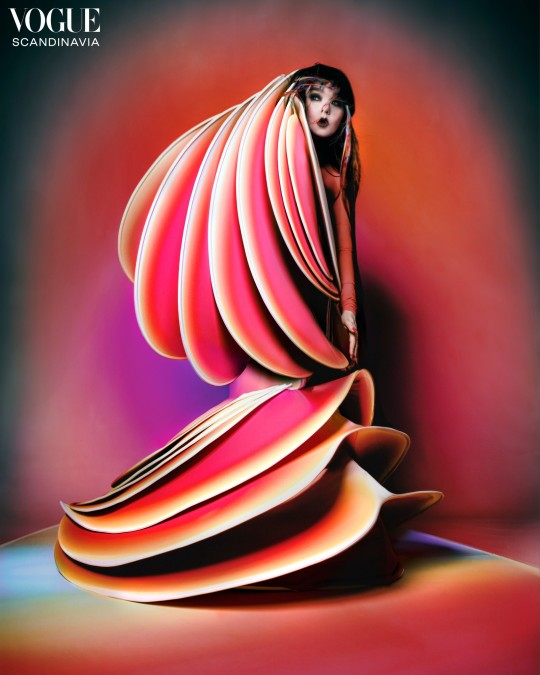



Björk, by Viðar Logi for Vogue Scandinavia, 2024
Styled by Edda Gudmundsdottir.
Björk tweeted:
'i am so honoured to be wearing this margiela dress !!
i got super mushy at the fashion shoot when i slipped on the prosthetic hips , it seemed such a full circle since the mannequin margiela-pieces i was wearing in the early 90́ s.
so wonderful how galliano threw away both of his and margiela ́s luggage and tapped into both of their beginnings .
i could see silhouettes of 1920 rooftop jumping irma vep vampires merging with margiela ́s first bellmer inspired poupée moment with a dash of duchamp ...
but then brought truthfully into 2024 by being all AI zombie like . is perhaps even jimbo there !? i wish .... such a profound thing ! i am so honoured to have gotten to wear this garment . i wore margiela for my first debut cover ( tinyurl.com/bjork-margiela ) so it is sentimental to me .
i would like to thank the wonderful viðar logi for the photos
and a special shout out goes out to edda gudmundsdottir and james merry for being my fashion team for my cornucopia tour , the outfits are chosen by me , refined and perfected in their hands . i couldn ́t do it without them .
thanks to andrew gallimore and olivier schawalder and sverrir páll sverrisson
photographer: viðar logi
words: liam hess
stylist: edda gudmundsdottir
makeup artist: andrew gallimore
hair stylist: olivier schawalder
masks: james merry
manicurist: cam tran
set designer: sophear van
executive production: directors lab
local production: lotti projects
maison margiela artisanal designed by john galliano @Margiela
@voguescandi
a selection of photos for vogue scandinavia @voguescandi
photos: viðar logi
stylist: edda gudmundsdottir
masks: james merry
makeup: andrew gallimore
hair stylist: olivier schawalder
manicurist: cam tran
set designer: sophear van
assistant: sverrir páll sverrisson
executive production: directors lab
local production: lotti projects
portal dress: KWK by KAYKWOK @KayKwokFashion
bodysuit: thora stefansdottir
full outfit & quill: robert wun @RobertWun
ophrys ring: james merry
hand embroidered dragonfly in petri dish: rahul mishra @RahulMishra_7
black dress: henrik vibskov
"fascia" mask: james merry
lace bodysuit: sinèad gorey
shoes by jean paul gaultier haute couture by simone rocha @JPGaultier
sequin embrodiere sculptural top, knit flight suit and latex straytukay boots: rick owens @RICKOWENSONLINE
bodysuit: CRITTER
"ophrys" handmade ring: james merry
harp: camac harps @CamacHarps
#bjork#björk#vogue#vogue scandinavia#fashion#editorial#fashion photography#viðar logi#edda gudmundsdottir#2024#maison margiela#john galliano#simone rocha for john paul gaultier#simone rocha#jean paul gaultier#rick owens#kaykwok#robert wun#james merry#thora stefansdottir#rahul mishra#henrik vibskov#sinead gorey#boots#harp#hat#irma vep#kwk#ink blot#mask
144 notes
·
View notes
Text
Eddie goes on Jimmy Fallon and they do that True Confessions game. The surprise guest that they bring out is Nancy. They pick which card that she has to read and She reads, “I stole drugs from a cop once…Sorry, Mom.”
Eddie, who has already opened one of his cards because he doesn’t follow the rules , holds the card up like, “Ha, mine says that I once sold drugs to a cop.”
At the same time they both say, “Hopper?” And then laughed about it like they didn’t ruin the whole segment.
Eddie’s just like: Alright, Wheels, make something up or don’t. We’ll try again. Give the people an interesting Nancy Wheeler factoid. That alright with you, Jimbo?
Nancy, after some thought: My first kiss was with a girl
Eddie: I don’t believe that! It took months for you to realize Robin was into you. Robin!
Nancy: It’s true! A first kiss is different than figuring out your sexuality, anyways. It was during spin the bottle. In seventh grade.
Eddie:
Nancy: I was dared to follow through
Eddie: Who’d you kiss?
Nancy: Barbara
Eddie: Well, that’s true. You’re not going to mention her and then lie. Sold yourself out, Wheeler.
Nancy: You go then
Eddie: …My first kiss was with a student athlete. *seeing Nancy get a look* Not Steve! We didn’t both lose our v-cards to King Steve.
Nancy: One day he’s going to divorce you for reminding people of that nickname
Eddie: Steve told me once that I never say anything he doesn’t already know in these interviews. He’s not watching them anymore.
Nancy: Was it Billy? Was it Tommy?
Eddie: it was before - when do you think I had my first kiss? Believe it not, I didn’t graduate high school a virgin
Nancy: No, i unfortunately know that. You guys were very loud. Give me a hint on who it was.
Eddie: It was a test to see if we were gay. Turns out I was. I don’t know about them though-
Nancy: Was it Jeff? He was on the wrestling for a bit, right?
Eddie: Heather Holloway
Nancy: What?!
Eddie: She was on the swim team and ran track. She used to run by where I’d smoke and we shared a few cigs, talked. Actually pretty cool for a conformist. You thought that I was questioning if I liked boys and immediately went for dick, Nance? That’s bold even for me.
#Jimmy is ignored this whole time because he talks too much#I spent forever trying to think of a minor character we knew that didn’t have too big of an age gap from Eddie#eddie munson tiktok saga#steve harrington#eddie munson
885 notes
·
View notes
Text
announcement - trevor zegras x famous singer!reader social media au
trevor zegras x famous singer!reader
a/n: if you thought it was the hard launch announcement lol. but this is the reader announcing good riddance deluxe edition...cause yes the readers life is basically gracie's in this au. hope you all like it and requests for this au are always open
yourusernameofficial
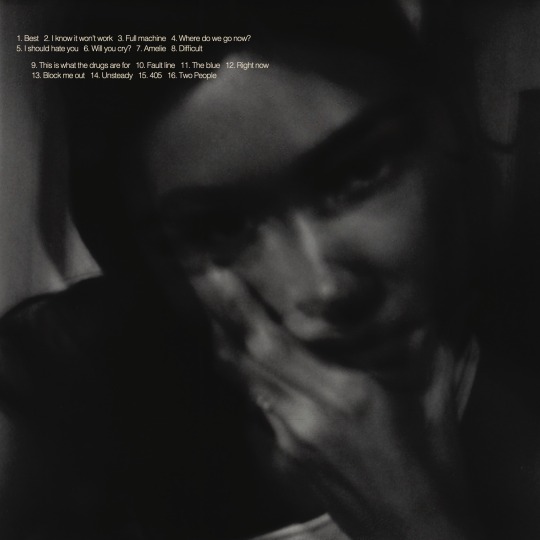



Liked by @/ trevorzegras, fanaccount3, maisiehpeters, and 700 897 others
yourusernameofficial - good riddance deluxe out june 16th🤍
View Top Comments
maisiehpeters - nobody is ready for this
↳ yourusernameofficial - you did cry when you listened to the bonus tracks for the first time
↳ maisiehpeters - babe i still cry after hearing them a million times
y/n#1fan - omg she's feeding us
radvxz - time for my bestie to break the internet :)
↳ yourusernameofficial - you think my music is break the internet worthy?? awwww
↳ radvxz - it's 100 times better than my music
↳ yourusernameofficial - shut the fuck up there is no music on planet earth that is better than your
↳ radvxz - yeah but maybe on mars right?
fanaccount3 - literally ordering the vinyl rn...but side note is that another like from a hockey player?? jamies teammate no less
↳ y/nupdatesss - okay okay i believe you and i am now on team y/n is dating jamie
peoplemagazine
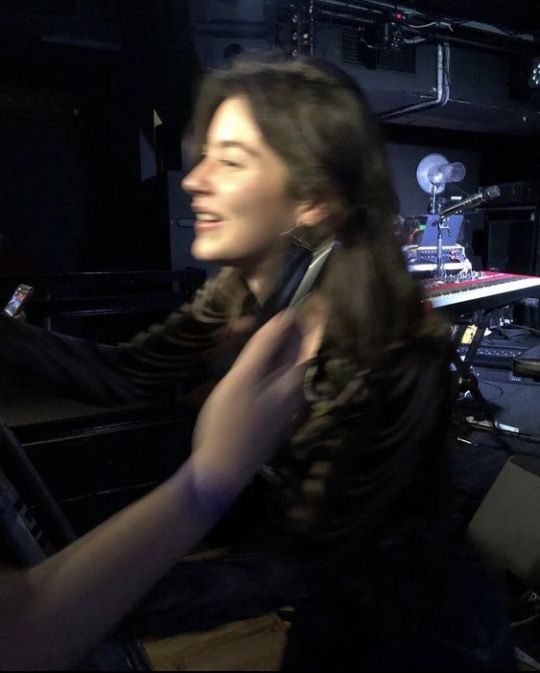

Liked by @/ fanaccount3, y/nupdatesss, y/n#1fan and 100 345 others
peoplemagazine - y/n l/n was seen out at dinner with best friend and singer, beatrice laus, better known as beabadoobee last night, amid rumors of an nhl player boyfriend. nothing has been confirmed but fans are speculating that it may be jamie drysdale, defensmen for the anaheim ducks.
Tagged: @/ yourusernameofficial & radvxz & jamie.drysdale
View Top Comments
fanaccount19 - i really hope they're dating...it would be such a cute pair!!
fanaccount3 - my thoughts have reached all the way to people magazine wow
y/n#1fan - i know we're all talking about the rumors but on a side note y/n and bea are slaying
trevorzegras



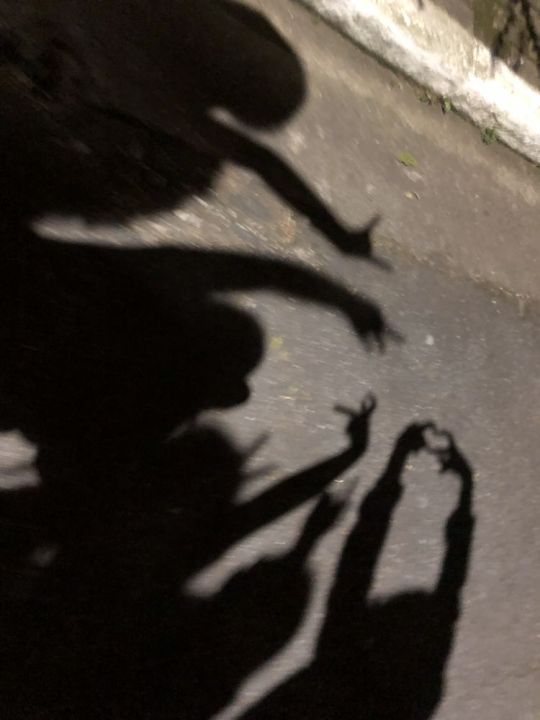

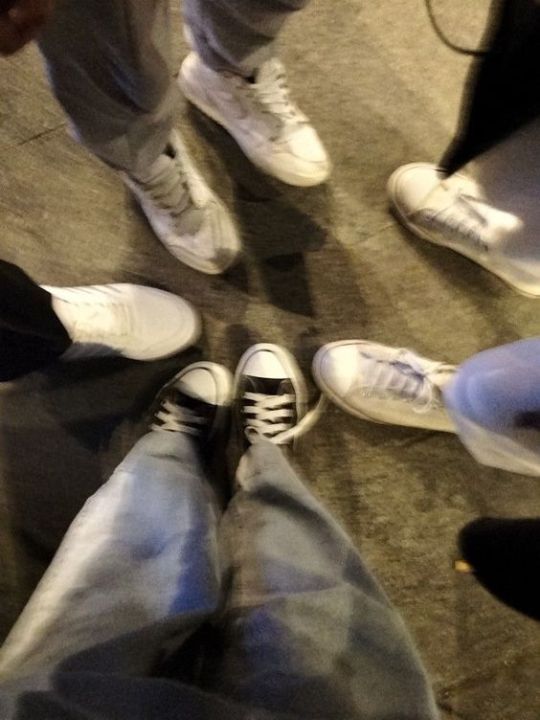
Liked by @/ maisiehpeters, jamie.drysdale, alexturcotte and 70 856 others
trevorzegras - last week in LA before me and jimbo parted for the summer...miss you bud
Tagged: @/ jamie.drysdale
hockeyfan25 - um trevor i think you forgot to tag 2 people...
nhlwag - the top right picture isn't sneaky dude, we see it
jackhughes - next stop lake house
↳ trevorzegras - summer trevor is unlocked baby
jamie.drysdale -its the way i took every single one of these pictures except for the one of me because trevor can't take a good picture to save his life
↳ trevorzegras - yes well at least im photogenic and look good in the pictures
↳ jamie.drysdale - ever so cocky trev
fanaccount3 - omg that has to be y/n...jamie and y/n are dating can't change my mind
↳ fanaccount6 - idk why is trevor posting her then...maybe we're all wrong and trevor is the guy??
thanks for reading🫶requests for this au are always open!!
taglist: @woodruff-edwards @nicohischierz @makarhughes @cobrakaisb @huggy-hischier94 @boldysswld@cole-mcward48@kashee-h@kjohnson-91 @jackhues @corneliaskates @imma-mirrorball @hvghes
join my taglist
#claires aus#trevor zegras x famous singer!reader#<- au tag#trevor zegras x reader#trevor zegras#x reader#nhl imagine#trevor zegras imagine#jack hughes#cole caufield#alex turcotte#claire tries writing <3#fake ig edit#social media au
212 notes
·
View notes
Text
Shoujo Manga’s Golden Decade (Part 1)
Shoujo manga, comics for girls, played a pivotal role in shaping Japanese girls' culture, and its dynamic evolution mirrors the prevailing trends and aspirations of the era. For many, this genre peaked in the 1970s. But why?

Manga stands as one of Japan's primary cultural exports, deeply ingrained in the local culture and enjoyed by individuals of all ages and genders across various genres. Conventionally, manga is divided into two editorial segments: shonen (targeted at boys) and shoujo (targeted at girls). While shonen manga, propelled by hits like "Dragon Ball," "Slam Dunk," "Naruto," and "One Piece," has achieved global popularity, girls' comics, with their own international sensations such as "Sailor Moon," hold a crucial position in the market. The evolving landscape of girls' manga serves as a fascinating lens through which to observe the shifting fashionable aspirations and beauty ideals within Japanese society.
Shoujo manga has a rich history, dating back to the early 20th century. However, it truly gained recognition in its modern form in the late '50s and early '60s when prominent Japanese publishers introduced shoujo manga anthologies such as Kodansha's Nakayoshi and Shoujo Friend, as well as Shueisha's Ribon and Margaret. The acclaimed "godfather of manga," Osamu Tezuka, is often credited with creating the first modern shoujo, "The Princess Knight," in 1954, and the first shonen, "Astro Boy," in 1952.
A distinguishing feature of shoujo manga is that it is created by and for girls. But, in the '50s, this wasn't the case, and male artists dominated the shoujo field, which was considered an entryway to the manga business. By the 1960s, that would change as publishers recognized that women creators possessed a unique proficiency in crafting narratives centered around female experiences. Female manga-kas resonated with readers in a way that many male artists couldn't, marking a crucial shift in the landscape of shoujo manga.
The Volleyball Craze
A notable display of how shoujo could mirror societal trends unfolded in the '60s. In 1964, the Tokyo Olympics marked a new beginning for post-war Japan, and the female volleyball team, known as Toyo no Majou (the Oriental Witches), achieved stardom by clinching victory in the finals against the Soviet Republic. This triumph triggered a nationwide "volleyball boom," resonating particularly within the shoujo manga realm.
Shueisha's Ribon, historically the leader in the shoujo manga field, started publication in 1955. Still, the editorial house would only begin to make its series available in standalone tankobon format almost 15 years later through the now iconic Ribon Mascot Comics imprint. The first series to be made available by the imprint was Chikako Ide's "Viva Volleyball."
Simultaneously, over at Kodansha, Shoujo Friend was also eager to capitalize on the boom. Editors commissioned a title about the sport from illustrator Akira Mochizuki and novelist Shiro Jimbo. The final project, "Sign wa V," became a multimedia success, being quickly adapted into a live-action TV drama that achieved very high ratings.
While "Viva! Volleyball" and "Sign wa V" enjoyed success in their time, they did not etch themselves into the collective memory. The true shoujo sports manga blockbuster, a cross-generational classic universally known in Japan, is Chikako Urano's "Attack No. 1," serialized from 1968 to 1970 in Weekly Margaret.

It became the first shoujo manga title to surpass ten tankobon volumes (it had a total of 12 volumes), and it was forever immortalized thanks to its 1970 anime adaptation, which reached huge ratings on Japanese TV. Everything about "Attack No. 1" -- from the original manga to the cartoon adaptation to the anime's theme song, which sold over 700k copies as a single -- was a success.
The story of a high school girl trying to become the best player in her school, in Japan, and, eventually, in the world became a phenomenon setting the stage for the '70s "golden era of shoujo."
The Shoujo Lost Years
Until the '70s, manga carried the stigma of being a guilty pleasure, often viewed as a "poison" meant to dumb down young readers. Despite a few discerning individuals recognizing the medium's potential, manga critics, enthusiasts, and tastemakers — predominantly men — largely disregarded female-centric comics. Shoujo manga, despite its immense popularity, faced the harshest criticism.
Because society and critics downplayed shoujo, influential shoujo manga-kas from the '50s and '60s, such as Hideko Mizuno, do not enjoy the same level of recognition as their shonen counterparts from that era.

Hideko Mizuno and a page of one of her most celebrated works, "Fire."
Mizuno was one of the first women to create manga, worked as an assistant to Osamu Tezuka, and was behind several massive hits that had a significant impact on women in the '50s, '60s, and '70s. In fact, the most iconic shoujo manga-kas from the '70s golden period directly mention her as an influence. She fought to include romance -- now the essential element in girls' manga -- in her works back when such topics were deemed inappropriate by male editors.
Mizuno's repertoire was vast: she wrote mangas about little girls and their poneys, magic adventures, and romcoms based on Audrey Hepburn's movies, and she drew the first sex scene in a shoujo manga. The manga in question was "Fire," a teen-targeted manga featuring a rebellious American rocker, which broke new ground by having a male character as its focal point. Alongside other notable female artists from the '60s, Mizuno laid the groundwork for the '70s shoujo explosion, during which girls' comics took center stage.

In 1960's "Hoshi no Tategoto" (left,) Hideko Mizuno created the first shoujo love story. Serialized in Weekly Margaret between 1964 and 65, "Shiroi Troika," set during the Russian Revolution, was the first historical shoujo manga.
A contributing factor to this "golden period" was the emergence of several shoujo mangas as unstoppable hits, selling millions of copies and becoming cultural phenomena. These titles, considered masterpieces, continue to be read and known by multiple generations.
The BeruBara Boom
"Attack No. 1"'s success spread far and wide, forcing Japanese society to take note of the potential of the shoujo segment. Right after this historic success, Shueisha's Weekly Margaret hit the jackpot once again with another epoch-defining manga hit, Ryoko Ikeda's "The Rose of Versailles," which debuted in 1972. Set in the years preceding and during the French Revolution, it weaved together historical figures like Marie Antoinette and fictional ones, like the iconic Lady Oscar, a handsome noblewoman raised as a boy to succeed her father as the commander of the Royal Guard at the Palace of Versailles.

The first volume of the original comic had Marie Antoinette on the cover as Margaret's editors believed she'd be the favorite character. However, the androgynous Lady Oscar turned into a fan fave and the absolute star of the series, which is reflected on the cover of most rereleases since then, including the 2013 bunko version seen above.
When talking about shoujo manga classics from the '70s recognized by literally everyone in Japan, "Rose of Versailles" is probably the first name that comes to mind. It was a hit that really defined the era and impacted the country as a whole. While Marie Antoinette is seen around the world as a tragic, out-of-touch figure, in Japan, many women and girls see her as an aspirational historical fashion icon. While Sofia Coppola's 2006 film "Marie Antoinette" solidified this among younger generations, it was Ikeda's gentle portrait that made her a character loved by so many across all age groups.
When conceptualizing the story, Ikeda was heavily inspired by Stefan Zweig's "Marie Antoinette: The Portrait of an Average Woman," which she read while in high school. Once in college, in the late '60s, she, like millions of others, was heavily involved with the Marxist student movements. These references led to a historical romance that touched on heavy and revolutionary themes, which was atypical for a shoujo manga, a segment that, back then, was primarily catered to elementary school-aged girls.
Because of its unorthodox concept, Margaret's editors were unsure about the series. But right from the start, "BeruBara" (derived from the original Japanese title, "Berusaiyu no Bara"), serialized between 1972 and 1973, was an explosive hit, quickly turning into Weekly Margaret's most popular series. It was compiled in 10 tankobon volumes published, which sold tens of millions of copies.
In 1974, after the original manga had finished its serialization, Takarazuka Revue, an all-female theatrical troupe, announced a stage adaptation of the story.
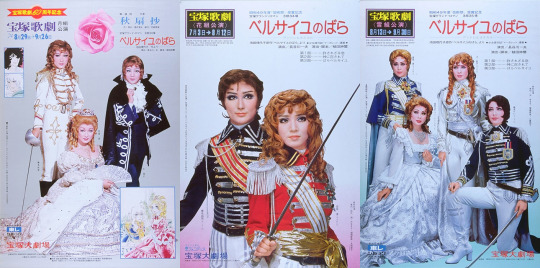
Posters of the first three Takarazuka adaptations, from between 1974 and 1975. Since then, the Revue has adapted the manga 11 times, with a new run scheduled for 2024.
The Revue was established in 1913 by the owner of Kansai's leading railway company, Hankyu, to boost tourism to the city of Takarazuka, his line's last stop. It was a huge success, and soon, the group had its own luxurious theater as well as its very exclusive academy where young ladies underwent an arduous audition process to become Takaraziennes. In 1934, a second Takarazuka theater opened in Tokyo.
However, in the early 1970s, Takarazuka faced stagnation, with declining ticket sales attributed to the growing popularity of alternative entertainment forms such as cinema and television.
In 1973, Shinji Ueda, who had risen through the Takarazuka ranks as a director, made his debut as a playwriter in the company with a musical based on ancient Japanese history. While thinking about his next project, he decided to check out a manga popular with some Takarazuka fans, "Rose of Versailles," and he quickly realized it was the perfect theme for an adaptation. Lady Oscar, who had lady-like features but was also as handsome as a man, was the embodiment of the male role-playing Takaraziennes. Ueda reached out to Ryoko Ikeda, who, as an admirer of the troupe, quickly granted the rights.
But Ikeda and Ueda's excitement wasn't shared by many. Most of the Takarazuka team were skeptical about a play inspired by something as vulgar as a manga. Fans of the original were also highly protective of its characters and entirely against a live adaptation.
Amid this climate of distrust, the play opened at the end of August 1974 at the Takarazuka Grand Theater. The reaction after the first night was extremely positive. Soon, Takarazuka's "Rose of Versailles" was the hottest ticket in all of Japan, with the press breathlessly covering the "BeruBara boom" that led thousands of people to stand hours in line to get tickets to the coveted performances in Kansai and Tokyo. Ikeda herself was shocked by the media phenomenon when she returned from an overseas trip and had hundreds of reporters awaiting her at the airport.
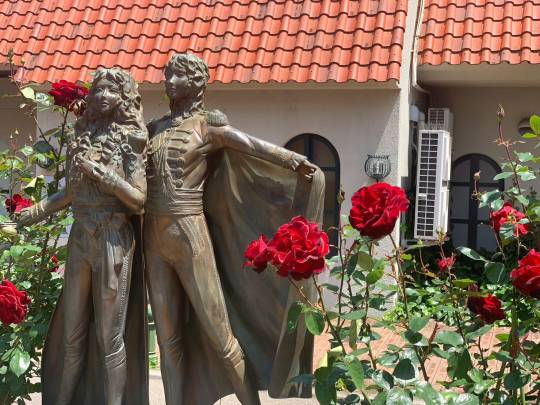
A statue of Lady Oscar and Andre surrounded by rose bushes sits outside the Takarazuka Grand Theater in Hyogo, Japan.
The "BeruBara" phenomenon single-handedly reversed Takarazuka's fortunes, leading to record-shattering ticket sales for the company. The Takarazuka Academy, which had seen declining applicants, suddenly became highly sought-after again, originating the saying "Todai in the East, Takarazuka in the West," comparing it to Tokyo University, the most prestigious university in Japan. The phrase underscored the desirability and prestige associated with a position at the troupe.
Ultimately, the success of "The Rose of Versailles" propelled Takarazuka back to the pinnacle of the entertainment industry, a position it maintains to this day. The brand continues to hold great esteem among women of all ages in Japan, with Takarazuka's stage adaptations, derived from Broadway musicals, movies, novels, and shoujo manga, consistently selling out. Notably, various adaptations of "BeruBara" have collectively sold over 5 million tickets since 1974.
Following the manga and Takarazuka adaptation's explosive success, the anime debuted in 1979. While the anime received acclaim, Ikeda herself was not entirely satisfied, mainly due to the treatment of her favorite character, Andre, who played a significant role in the manga but had a minor presence in the animated version, which focused almost entirely on the manga's most popular character, Lady Oscar.

In 2013, celebrating Margaret's 50th anniversary, new special chapters of "BeruBara" were published. The first new story in 40 years resulted in Margaret magazine selling out across the country.
"BeruBara" remains a prominent franchise in Japan, spawning numerous licensed products, sequels, and spin-offs. Ryoko Ikeda, known for other successful series, continues to garner widespread respect and media attention. However, while almost everything related to "The Rose of Versailles" turned into a hit, there was an exception.
In March 1979, a few months before the anime premiere, a live-action film adaptation debuted with great fanfare. Fittingly for such a hot property, the movie was one of the most ambitious productions in Japanese cinema, with a substantial 1 billion yen budget.
The Palace of Versailles granted permission to shoot in its interior. The film was filmed in English, with a European cast. The project was helmed by France's hottest movie director, Jacques Demy. Demy wasn't respected only in the West but also in Japan, where his two most important films, "The Umbrellas of Cherbourg" (1964) and "The Young Girls of Rochefort (1967)," were also hits. In fact, to this day, both flicks remain popular among trend-conscious Japanese as examples of stylish oshare movies that fully capture aspirational girls' culture (alongside, among others, Sofia Coppola's "Marie Antoinette"). Demy, the mind behind dreamy, girly movies, seemed like the perfect choice to turn this blockbuster shoujo classic into a live-action film.
The movie had the backing of three gigantic domestic corporations: Toho, the leading Japanese movie distributor; Nihon Terebi (NTV), one of the main TV stations; and cosmetic giant Shiseido. NTV and Shiseido made sure the movie had one of the most extensive marketing campaigns Japan had ever witnessed. The TV station aired specials and segments on this grand production. Meanwhile, Shiseido made the star of the movie -- British actress Catriona McCall, who played Oscar -- the face of its spring campaign, promoting its new Red Rose lipstick. Catriona was plastered on billboards across the country, made media and department store appearances, and starred in luxurious TV spots.

On the left, Lady Oscar and Marie Antoinette adorn the cover of Margaret in 2016, over 40 years after the end of the original serialization. On the right, Oscar models Dolce & Gabanna new collection for high-end fashion magazine Spur in 2014, celebrating 40 years of the conclusion of the original manga.
Back then, Kanebo, the second biggest local cosmetic company, was in fierce competition with Shiseido. TV ads from both companies had a tremendous impact, propelling singles to the top of the charts, and there was a battle on which commercial would feature the biggest hit. But, in the spring of 79, the focus of the fight changed. As a response to the Catriona "Rose of Versailles" campaign, Kanebo also hired a British beauty, actress Olivia Hussey, and launched a "Super Rose lipstick" with the tagline "You are more beautiful than a rose." The cosmetics war was another proof of the chokehold "The Rose of Versailles" had in the decade.
But, when the movie finally premiered, it was a flop. Critics hated it. Japanese fans thought the adaptation was weak and lacked impact. Catriona, in particular, was very criticized for not conveying Oscar's androgynous charm, which perfectly balanced masculinity and femininity. With the well-received anime premiering just a few months later, the expensive movie adaptation ended up being outshined and forgotten. It became only a costly footnote in its history.
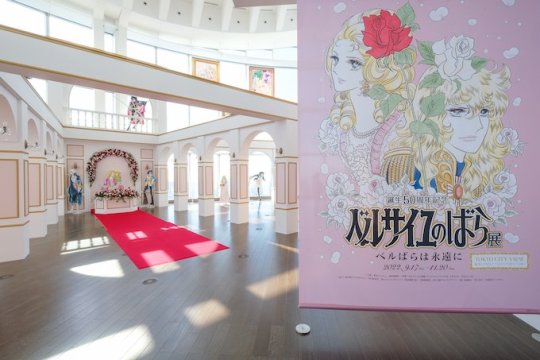
An exhibition in Tokyo celebrates 50 years of BeruBara in 2022.
(It's worth noting that Kanebo clearly won the CM war. The "You Are More Beautiful than a Rose" song they commissioned from singer Akira Fuse became a considerable hit).
Movie aside, "The Rose of Versailles" is one of Japan's most beloved comics. From its debut in 1971 to its film and anime adaptation in 1979, it remained front and center in the country's mind throughout the whole decade. Its impact was felt in different fields, from the cosmetic business to the publishing business, from live theater to TV. It also forever changed how shoujo manga was perceived and remains one of the country's most beloved properties.
Ace-Scoring Manga
The 1970s marked a turning point for shoujo manga, as it began to gain recognition beyond its traditional audience, propelled not just by critical acclaim but by commercial success. The era witnessed the emergence of several blockbusters that captured the public's imagination. Notable among them were Yoko Shoji's "Seito Shokun," a tale centered on the daily exploits of a mischievous high-schooler, and Waki Yamato's "Haikara-san ga Toru," a love story set in the Meiji period featuring a tomboy with a lady-like demeanor. These manga were significant hits during their publication in Shoujo Friends, becoming best-selling titles.
Some shoujo classics from the '70s are still in publication today, appealing to a diverse readership spanning multiple generations. Suzue Michi's "Glass Mask," serialized in Hana to Yume since 1976, remains a cultural phenomenon with 49 tankobon volumes, over 55 million copies sold, an anime adaptation, a live-action drama, and a stage play. Similarly, Chieko Hosokawa's "Crest of the Royal Family," chronicling the adventures of a young American girl transported to ancient Egypt, has been a consistent presence in Princess magazine since 1976, boasting 69 volumes and over 45 million copies sold to date.
But, when talking about definitive shoujo classics from the '70s, titles that were historical successes, influenced everything going forward, and are known by everyone, three titles come to mind. We already explored one of these, "The Rose of Versailles." One of the other three is "Ace wo Nerae."

Following the monumental success of "Attack No. 1," the prospects of another shoujo sports manga achieving similar heights of popularity seemed improbable. However, Weekly Margaret defied expectations once more in 1973 with the release of Suzumika Yamamoto's "Ace wo Nerae" ("Aim for the Ace"), a compelling narrative focused on tennis that swiftly captured the nation's attention.
Japan and tennis already had some prior history. The first Japanese Olympic medalist was a tennis player, Ichy Kumagae, in 1920. Emperor Akihito met his commoner wife, Michiko, at a tennis match, and they initially bonded over their love for the sport. But, in the 70s, the country was taken over by an unprecedented tennis boom. At high schools across the nation, tennis became the most popular after-school activity. Fashion magazines like JJ and Popeye dedicated pages and pages to "tennis fashion." At the same time, trendy young adults decked in clothes from sports brands populated Shibuya and other stylish districts in Tokyo.
There were several contributors to the tennis boom. But the remarkable success of "Ace wo Nerae," which first conquered girls before dominating the nation, played a part in it.
The manga follows the journey of Hiromi Oka, a high school student initially plagued by insecurities but propelled into the world of tennis through the encouragement of her coach. "Ace wo Nerae" portrays her growth from a hesitant newcomer to a world-class tennis player, navigating challenges and discovering hidden potential along the way.

From left to right: Madame Butterfly, lead character Hiromi Oka and coach Jin Murakata as depicted in the anime. Madame Butterfly, a rich wealthy student who was gentle and a world-class tennis player, is a fan favorite character.
In 1973, "Ace wo Nerae" was adapted into an anime. Despite initial modest ratings, the anime gained popularity through reruns. Encouraged by this, NTV decided to remake the cartoon. The second adaptation, which debuted in 1978, was an immediate hit. Concurrently, Weekly Margaret revived the manga series, which, after being first finalized in 1975, ran again from 1978 to 1980, spanning a total of 18 volumes.
Since "Ace wo Nerae," several hit mangas focused on tennis -- both shoujo and shonen -- were published. But, thanks to the success of its anime and the intragenerational support for the manga, the original work by Suzumika Yamamoto is still considered one of the defining and most beloved works about the sport. Its role in propelling tennis culture as part of the oshare youth culture of the '70s also defines its impact.
Japan Wants Candy
Following the monumental multimedia success of "The Rose of Versailles" and "Ace wo Nerae," the third shoujo sensation of the '70s is "Candy Candy."

Initially published in Nakayoshi, the story started taking shape when editors at the magazine sought a work of literary excellence akin to beloved classics popular among girls, like "Heidi" and "Anne of Green Gables." They enlisted Keiko Nagita, writing under the pen name Kyoko Mizuki, and paired her with one of the magazine's most famous artists, Yumiko Igarashi. The collaborative effort resulted in the creation of "Candy Candy," centered around an American, blond, blue-eyed orphan named Candice "Candy" White Ardlay.
"Candy Candy" epitomized various shoujo directions prevalent in the '70s. The protagonist, a white girl with lustrous blonde hair, embodied the fascination with Western culture during a time when Japanese youth held a keen interest in Europe and the United States. The manga's narrative style, characterized by its dramatic tone and intricate plot twists, also aligned with the prevalent storytelling preferences of the era.
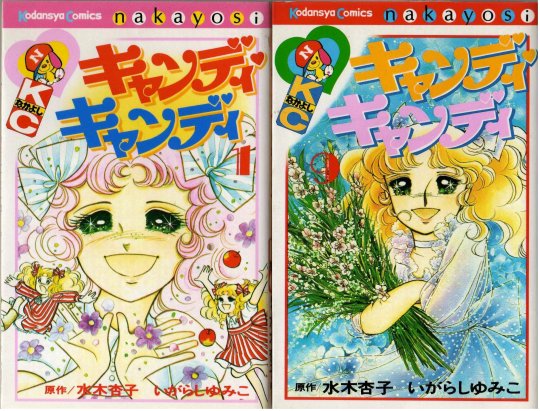
Candy Candy was such a resounding success that it became the first manga to achieve an initial print run of over 1 million copies of one of its paperback compilations.
Debuting in 1975, "Candy Candy" swiftly captured the hearts of Nakayoshi's readers, leading to unprecedented success. The subsequent anime adaptation by Toei in the following year propelled the franchise into the realm of a cultural phenomenon, sending manga tankobon sales skyrocketing. The seventh volume of the "Candy Candy" compiled paperback reportedly became the first Japanese manga to achieve an initial print run of over 1 million copies. Additionally, Nakayoshi's sales surged, surpassing those of Shueisha's Ribon for the first (and only) time.
The adventures of young Candy were also licensing gold. With over 100 licensed products, the "Candy Candy" doll alone sold 2 million units, solidifying Bandai's position as Japan's premier toymaker, a status it continues to uphold to this day. The resounding success of "Candy Candy" forged a lasting alliance between Kodansha's Nakayoshi, Toei Animation, and toymaker Bandai, which led to the iconic "Sailor Moon" franchise in the 1990s.
While "Candy Candy" concluded its run in 1979, its appeal extended far beyond its original target demographic, captivating kids, teenagers, and adults alike, thus contributing significantly to the manga and anime's widespread acclaim and enduring popularity.
However, a protracted legal dispute between Igarashi and Nagita has prevented the commercialization of any "Candy Candy" related products since the late 1990s, including reprints of the manga and re-broadcasting of the anime. The lawsuit arose from Igarashi's unauthorized licensing of merchandise based on the franchise, falsely asserting sole ownership of the copyright. Although Igarashi was initially credited as the lead artist in Nakayoshi during the manga's publication, the court ultimately ruled in Nagita's favor, emphasizing that Igarashi's artistic foundation was built upon Nagita's written work.
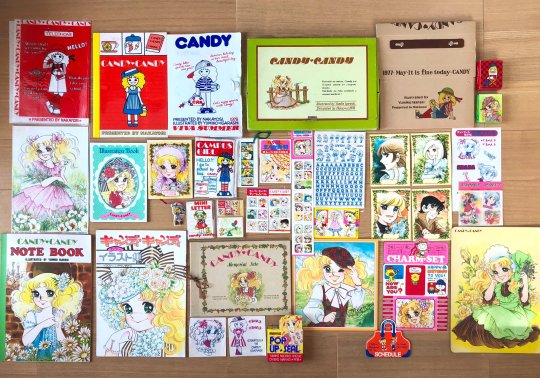
A collection of "Candy Candy" freebies offered by Nakayoshi magazine in the '70s. During the publication of the series, Nakayoshi would eclipse Ribon's sales for the one and only time in its history, (image credit)
Consequently, any commercial exploitation of Yumiko Igarashi's "Candy Candy" artwork necessitates the approval of both Igarashi and Nagita, a challenging prospect given the existing feud. Nagita, on the other hand, can profit from "Candy Candy" as long as she doesn't include any illustrations, which allowed her to release a book sequel in 2010. However, due to the dispute, one of the most beloved works in Japanese manga history is currently out of print. The lawsuit also blocks the anime from being aired or distributed. But, despite the almost two-decades-long media ban, "Candy Candy" remains widely known and beloved across Japan, a testament to its staying power.
While smash hits like "Candy Candy," "Ace wo Nerae," "Rose of Versailles," "Seito Shokun," "Hikara-san ga Tooru," and "Glass Mask," among others were key pieces into shoujo finally earning the respect it deserved, the rise of a revolutionary group of artists during the '70s was another critical element in shoujo's rise: the Year of 24 Group.
Part 2
#1970s japan#1970s#vintage shoujo#shoujo manga#lady oscar#rose of versailles#ace wo nerae#candy candy
56 notes
·
View notes